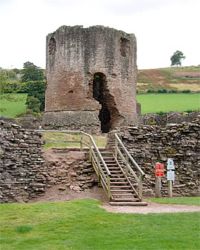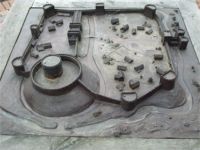|
Alan E. Paull is a well known game designer. He
recently created games like
Tara, Seat of Kings or
Confucius. Alan has been kind enough to chat
with me on December 8 and 9, 2008. Below is the
transcript of our conversation.
Buxeria: Alan, I’m really thankful that you
accepted to answer my questions for Cry Havoc Fan.
Alan E. Paull: Happy to answer any questions you
have! Nice looking website by the way.
B. : Just to start, I would like to focus on
your contribution to the CRY HAVOC series. My
understanding is that you were the designer of SIEGE
and SAMURAI BLADES, as well as |
 |
the author of the first scenario
booklet for CRY HAVOC. Is this correct? Bob Gingell, another
Cry Havoc fan that contacted you a few years ago mentioned
that you were also the author of OUTREMER. Is this true?
A.P. : I was the designer of SIEGE and the first scenario
booklet. SAMURAI BLADES was designed by Peter O’Toole; I was
a developer and tester for that one. I did not design
OUTREMER. I was going to be the designer of OUTREMER, on the
grounds that we were going to re-design the whole game
system, but Standard Games double-crossed me and got someone
else to design OUTREMER without reference to me, and
(without permission) used some of the Siege mechanics. I was
not pleased, because we had developed a far superior game
system, which I still have and which was never published.
Unfortunately OUTREMER was primarily a continuation of the
earlier games; and the new system would have taken the whole
thing to a much better level; it included proper charge
rules, integrated morale rules, and was all-in-all far
superior.
B. : How did you start your relationship with Standard
Games on SIEGE? Was it "just" another contract job for you
or something more profound? Did you have any initial contact
with the original designers of CRY HAVOC, Gary Chalk and
Tony Webster?
A.P. : I was a new game designer when I first met the
Standard Games people. Gary Chalk was a director at that
time, and I worked with Gary on my first game –
City of Sorcerers (my first published game). Gary did
the artwork for CoS. SIEGE was a commission from them,
largely because they had committed to producing the game
with that title but had no designer to do it. Gary had
started to work on it, but wasn’t getting very far, and left
after CoS was finished and well before SIEGE was done. I was
/ am a military historian (amateur now), so I had a lot of
relevant background information, and I had toyed with quite
a few military game designs in the past. I also have a good
friend who knows huge amounts about medieval warfare and
castles in particular, so I had great sources of
information, encouragement and reality checks. So although
it was a commission, I was very happy to do it, because it
was in my area of interest. I never had any contact with
Tony Webster, and Gary left soon after I met up with the
company.
B. : For SIEGE, what has been your exact contribution
as a designer? I know that Peter Dennis designed the
counters. What about the Castle and Camp maps?
| A.P. :
All the game design and development was mine.
Graphic design of the counters and the maps was by
Peter Dennis (who I like a lot – he’s probably the
top UK board games graphic designer). It’s important
to note however that the game-related layout of the
terrain and so on, is part of the game design rather
than graphic design. Peter did a great job on the
graphics; I would have preferred to have had time to
work more closely with him on the relationship
between the graphic design and the game design, but
in this case it was done separately. So in terms of
the maps, I showed where the bits had to go, and
Peter did the creative stuff. The challenge of that
game was to do the whole thing in 9 months, which
was the time-scale set by the commercial imperative.
Normally games take 2 to 5 years (sometimes more)
from concept to finished design, then production
time on top. To do it all in 9 months was difficult,
even though we were constrained to be compatible
with CRY HAVOC. C.H. had no mechanisms for siege
warfare, and no morale rules, which were essential
for any sense of realism. Also we had to design the
castle itself. I decided, for reasons of scale to
use a Welsh border castle:
Skenfrith. |

Skenfrith Castle |
|
I’d wanted to base it on
Bedford Castle (a famous and well documented
royal siege took place there), but it was too big
for the ground scale. Incidentally, we were
criticized by someone who bought the game, who
claimed that the castle was totally unrealistic; in
fact the castle map was reasonably well scaled to
Skenfrith Castle, so that’s one aspect of the game
system that cannot really be questioned!
B. : 25 (or more) years later, what is your
memory of this game? Is there anything that you are
particularly proud of? Is there anything that you
would have done differently? Any regrets? |

Model of Bedford Castle |
A.P. : I was happy that the game was finished on time,
because the time scales were probably only about a third of
what might have been required, and that it turned out to be
a much-loved and much-played game. I certainly enjoyed
designing and playing it. I particularly liked the graduated
learning of the game system, so that it was more accessible
than a lot of other military games of the period; you could
get to grips with the basics before moving on to the more
complex bits. Of course nowadays you could easily get away
with presenting the whole thing in one go, because even
casual players of military board wargames are used to that
type of thing.
I would have preferred to have spent more time on game
development, making sure the wording of the rules was
tighter in particular. When I’m designing games now, I’m
pretty much guaranteed to re-write the rules from scratch at
least three times.
B. : Would you have in your archives any
unpublished/unfinished material for SIEGE that you would be
willing to share with us?
A.P. : Unfortunately I don’t. This is partly because I
have a whole (new) finished Crusades game that I worked on,
that I might produce soon, once I’ve updated it for more
modern tastes.
B. : Waoh! It is quite mouth-watering and you will
make the Cry Havoc community very excited! Will it include
any concepts that you intended for the original OUTREMER
game? When do you plan to release it?
AP: We’re not yet sure of our plans for that yet. It may
be that we’ll produce a rule set, some maps and perhaps some
illustrated components, but let the player buy miniatures.
It will be based on stuff I intended to do for the Crusades
game. I’ll release information when things are a bit better
worked out - on the
Surprised Stare Games website.
B. : I strongly believe that the success of the CRY
HAVOC games over time has to do with the quality of their
artwork, and their innovative counter structure. How do you
explain that this system didn't become a standard for
simulation games? I throw a few possible answers:
- Graphic designers like Peter Dennis are not cheap, and the
production cost must be very high;
- Standard Games owned a Copyright on the game system that
would have been very costly to infringe;
- Market walked away from man-to-man, ambush style games and
this concept was not exportable beyond its original intent.
A.P. : Production cost was very high – Peter had to do
separate illustrations for each figure, which is a lot of
illustration. Also the materials used were expensive, and
initially only viable because Standard Games was attached to
a print company. I guess that the quality could have been
increased slightly – say, to use heavier weight card for the
counters – then a higher price could have been set.
Copyright wasn’t an issue. In fact I retained (and still
retain) the copyright in SIEGE. I think that
miniatures-based board wargames would have been a good
solution.
B. : Now, a few questions about SAMURAI BLADES, even
though you may not have all the answers.
A.P. : Please note that you should credit Peter O’Toole
for SAMURAI BLADES – I was only involved in the development!
I wouldn’t like people to misunderstand and think that I
designed it; not that it’s bad though!
B. : All right, so in this case you were the developer
while Peter O'Toole was the designer. What is the
distinction between both functions? One is more "strategic"
while the other one is more "tactical"?
A.P. : It’s Peter O’Toole’s game: he did the game design
and most of the development; I merely assisted with
development and play testing. The designer is responsible
for the game concept, the design of the mechanics and
components, and usually the first cut of the rules. Game
development is the process of taking that initial working
game design and turning into the finished pre-production
prototype. This often involves tinkering about with the
mechanics to a greater or lesser degree, sometimes
experimenting with additional mechanics or refining original
concepts. If you have a good game design, the development
process can often turn it into an excellent game design.
Usually the designer has the final say in decisions about
game development (though not always with some game
companies). In the CRY HAVOC series, the designer usually
did most of the development too. Some companies will take
the design and put their own development team on it – not a
situation I myself favor. Also some game designers are not
good at writing game rules, and it’s rarely a good idea for
a designer to rely on just his or her own abilities; it’s
better to have a team to help.
B. : What was the "marketing pitch" for SAMURAI
BLADES? Selecting Medieval Japan as a continuation of the
Cry Havoc series was quite unusual (and the lack of success
of that game proved it to be a bad choice after all). Do you
know who made this decision?
A.P. : I don’t know the answer to that one. I suspect it
was a commission from Standard Games to Peter, because they
wanted to continue the series. It’s not a bad choice for a
theme, bearing in mind (now) the success of medieval Japan
themed games (Samurai, Shogun X 2, etc). Peter O’Toole had
done a WW2 game for Standard Games called “Speed
and Steel”, so he was known to SG. Unfortunately, I
haven’t been in contact with Peter for over 15 years.
B. : Alan, thank you again for your invaluable
contribution, and for providing us with so much
entertainment over the last 25 years with SIEGE! |
